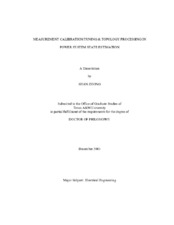| dc.contributor.advisor | Abur, Ali | |
| dc.creator | Zhong, Shan | |
| dc.date.accessioned | 2005-02-17T21:06:53Z | |
| dc.date.available | 2005-02-17T21:06:53Z | |
| dc.date.created | 2003-12 | |
| dc.date.issued | 2005-02-17 | |
| dc.identifier.uri | https://hdl.handle.net/1969.1/1595 | |
| dc.description.abstract | State estimation plays an important role in modern power systems. The errors in the telemetered measurements and the connectivity information of the network will greatly contaminate the estimated system state. This dissertation provides solutions to suppress the influences of these errors.
A two-stage state estimation algorithm has been utilized in topology error identification in the past decade. Chapter II discusses the implementation of this algorithm. A concise substation model is defined for this purpose. A friendly user interface that incorporates the two-stage algorithm into the conventional state estimator is developed.
The performances of the two-stage state estimation algorithms rely on accurate determination of suspect substations. A comprehensive identification procedure is described in chapter III. In order to evaluate the proposed procedure, a topology error library is created. Several identification methods are comparatively tested using this library.
A remote measurement calibration method is presented in chapter IV. The un-calibrated quantities can be related to the true values by the characteristic functions. The conventional state estimation algorithm is modified to include the parameters of these functions. Hence they can be estimated along with the system state variables and used to calibrate the measurements. The measurements taken at different time instants are utilized to minimize the influence of the random errors.
A method for auto tuning of measurement weights in state estimation is described in chapter V. Two alternative ways to estimate the measurement random error variances are discussed. They are both tested on simulation data generated based on IEEE systems. Their performances are compared. A comprehensive solution, which contains an initialization process and a recursively updating process, is presented.
Chapter VI investigates the errors introduced in the positive sequence state estimation due to the usual assumptions of having fully balanced bus loads/generations and continuously transposed transmission lines. Several tests are conducted using different assumptions regarding the availability of single and multi-phase measurements. It is demonstrated that incomplete metering of three-phase system quantities may lead to significant errors in the positive sequence state estimates for certain cases. A novel sequence domain three-phase state estimation algorithm is proposed to solve this problem. | en |
| dc.format.extent | 5916100 bytes | en |
| dc.format.medium | electronic | en |
| dc.format.mimetype | application/pdf | |
| dc.language.iso | en_US | |
| dc.publisher | Texas A&M University | |
| dc.subject | Power System State Estimation | en |
| dc.subject | Topology Error Identification | en |
| dc.subject | Remote Measurement Calibration | en |
| dc.subject | Parameter Estimation | en |
| dc.subject | Auto Tuning | en |
| dc.subject | Measurement Weight | en |
| dc.subject | Random Error Variances | en |
| dc.subject | Three-Phase State Estimation | en |
| dc.subject | NonTransposed Lines | en |
| dc.subject | Unbalanced Loads | en |
| dc.subject | Current Injection Method | en |
| dc.subject | Sequence Component | en |
| dc.title | Measurement calibration/tuning & topology processing in power system state estimation | en |
| dc.type | Book | en |
| dc.type | Thesis | en |
| thesis.degree.department | Electrical Engineering | en |
| thesis.degree.discipline | Electrical Engineering | en |
| thesis.degree.grantor | Texas A&M University | en |
| thesis.degree.name | Doctor of Philosophy | en |
| thesis.degree.level | Doctoral | en |
| dc.contributor.committeeMember | Halverson, Don R. | |
| dc.contributor.committeeMember | Kezunovic, Mladen | |
| dc.contributor.committeeMember | Sarin, Vivek | |
| dc.type.genre | Electronic Dissertation | en |
| dc.type.material | text | en |
| dc.format.digitalOrigin | born digital | en |


